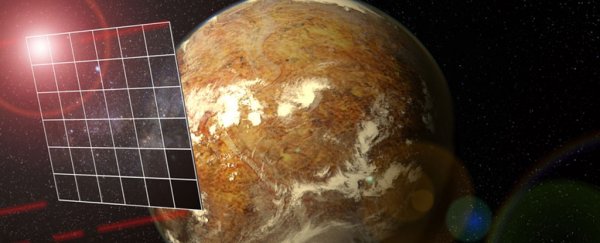Of all humankind's audacious schemes to explore the galaxy, Breakthrough Starshot could literally be the most 'out there': using lasers to send a postage-stamp-sized spacecraft to our nearest star system, Alpha Centauri.
Travelling at 20 percent the speed of light, this nano-probe could make the 4.37-light-year journey in just 20 Earth years – and might give us a chance to study the closest known Earth-like planet outside our Solar System, Proxima b, which may support life.
The only question is, at that blistering pace, how do you actually slow down? Scientists think they might how have an answer.
Researchers in Germany have come up with a way of applying the brakes to an interstellar spacecraft travelling at up to 13,800 kilometres (8574.9 miles) per second.
Brakes are pretty mandatory in cases like this, because without a way to slow down, an interstellar probe could overshoot an entire solar system in seconds, leaving very little time to actually collect information on whatever cosmic body it set out to investigate.
"The time for a few snapshots is only seconds, and if you miss the target, it's all for nothing," astrophysicist Michael Hippke told Nadia Drake at National Geographic.
"In contrast, if you manage to go in orbit around your target, you can stay there as long as your probe functions."
Hippke and fellow researcher René Heller from the Max Planck Institute for Solar System Research say that one way to apply the brakes and swing into orbit would be to deploy a solar sail when the spaceship gets close to its destination, and use the radiation and gravity of the Alpha Centauri stars to decelerate the craft.
In their new study, they envision a spacecraft that's bigger than the postage stamp dimensions of the Breakthrough Starshot probe – but still only about the size and weight (less than 100 grams) of a bar of soap.
While the Breakthrough Starshot craft is being built to have lasers fire onto its backside from Earth as a propellant, the German plan is to connect the ship to a massive lightweight sail, measuring 100,000 square metres – equivalent to around 14 soccer fields.
This sail would catch photons from the Sun to speed up the craft and send it on its way to Alpha Centauri, and the same principle could then be used in reverse: once the probe reaches its destination, radiation from Alpha Centauri's stars would hit the sail, applying a braking force to the probe.
In the researchers' calculations, the shield would need to be deployed by the time the craft got within 4 million kilometres (2.49 million miles) of the star Alpha Centauri A.
While photons from the star would hit the sail and slow the craft down, the craft would also be affected by Alpha Centauri A's gravitational field.
Not only would this mean that the probe might be able to settle into a bound orbit around Alpha Centauri A, but the researchers think that the vessel might be able to use the radiation from the star to steer its way to Alpha Centauri B, and even potentially on to Proxima Centauri – the system's third star, which hosts Proxima b, an Earth-like planet that could turn out to be habitable.
It all sounds totally fantastic, but while the researchers' sail-based craft could offer valuable manoeuvrability that Breakthrough Starshot currently lacks, it comes at a cost: speed.
Breakthrough Starshot is projected to reach 20 percent the speed of light, which means it could arrive at Alpha Centauri in just 20 years.
By contrast, the light-sail vessel would only reach 4.6 percent of the speed of light (13,800 kilometres or 8574.9 miles per second), meaning it would take about 95 years to reach the star system, then another 46 years or so before it got to Proxima Centauri.
Of course, the fact that any of this is even hypothetically possible is still hugely encouraging – but that extended mission timeframe does sadly chip away at the tantalising imminence of Breakthrough Starshot.
"Our main constraint in defining the Starshot concept was to visit Alpha Centauri within our lifetime," astrophysicist Avi Loeb from Harvard University, the chief scientist on the project, told National Geographic.
While the solar sail craft might be slower than Breakthrough Starshot in the researchers' hypothetical model, the team thinks improvements made to the sail – currently envisaged to be constructed from graphene – could ultimately enable it to become faster, as well as helping it absorb radiation to power the ship and its communications systems.
The researchers are in discussion with members of the Breakthrough Starshot Initiative, to see whether their research could open up new ideas for the US$100 million project.
If not, the dual concepts aren't mutually exclusive, and it's quite possible that research missions involving multiple kinds of probes could each help us explore the galaxy in their own distinct ways.
"Our new mission concept could yield a high scientific return, but only the grandchildren of our grandchildren would receive it," Heller said in a press release.
"Starshot, on the other hand, works on a timescale of decades and could be realised in one generation. So we might have identified a long-term, follow-up concept for Starshot."
The findings are reported in The Astrophysical Journal Letters.
